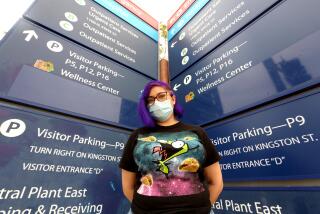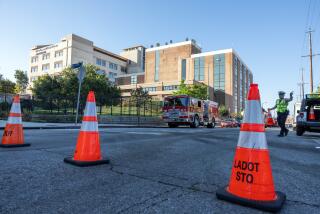King-Harbor is quiet after ER closure
- Share via
A day after Martin Luther King Jr.-Harbor Hospital closed its emergency room, protesters filled its front lawn Saturday but patients largely stayed away from both the medical center and neighboring hospitals that would have to pick up the slack.
In the morning and afternoon, only a handful of patients came to the emergency room entrance, which had signs announcing its closure and security officers on hand to redirect visitors. Four parked police cars encircled the closed unit, and the only people going in or out were officers or a few nurses who were taking smoking breaks.
“I think people have gotten the initial message,” said Dr. Bruce Chernof, director of the Los Angeles County Department of Health Services.
“It’s almost unbelievably quiet,” Carol Meyer, the agency’s director of government relations, said about 5 p.m.
County officials announced King-Harbor’s impending closure Friday afternoon, shortly after the federal government said it would pull the hospital’s funding because it was chronically unable to meet minimum patient care standards.
The emergency room was closed within hours because it did not have enough nursing staff to safely care for patients. Inpatient units will be closed within two weeks as patients are discharged or transferred to other hospitals.
Outpatient clinics at King-Harbor will remain open, as will an urgent care center, which will operate daily from 8 a.m. to midnight.
Neighboring emergency rooms, which will now be responsible for treating many of the 47,000 patients annually who had gone to King-Harbor, said they were managing so far. But, they said, it’s too early to say if that would last.
Each day, King-Harbor handled about 125 emergency room patients, about 30 of whom came by ambulance. The hospital, formerly known as King/Drew, serves disproportionately poor and minority neighborhoods of South Los Angeles.
“It appears the patients have not gone to one particular medical center, but are dispersing to the various medical centers in the community,” said Richard DeCarlo, chief operating officer for Long Beach Memorial Medical Center and Miller Children’s Hospital. “So far, it has worked fairly well for medical centers picking up the slack.”
St. Francis Medical Center in Lynwood, a 2.7-mile drive from King-Harbor, saw more patients than usual admitted Friday night, but the rise was “not remarkably high,” said Carol Lee Thorpe, a spokeswoman for the hospital.
“It definitely wasn’t a light night, but it wasn’t an alarmingly high volume,” Thorpe said. “We were able to handle it in an orderly fashion.”
St. Francis officials set up an overflow waiting room of about 30 chairs, and double-checked on-call lists to make sure enough doctors and nurses could be summoned in case of an influx. The hospital also is in the midst of expanding because of increasing demand.
Downey Regional Medical Center saw its hospital admissions increase early last week, even before King-Harbor’s emergency room officially closed.
On Monday, King-Harbor declared an internal disaster after suffering a staff shortage, causing ambulances to be diverted. Downey saw a 23% increase in the number of patients who were admitted, from 138 Monday afternoon to 170 Tuesday morning -- near Downey’s capacity, said Rob Fuller, chief operating officer.
By Saturday morning, the crunch had eased slightly, with a patient census of 160. But officials were gearing up for another surge of patients today and Monday, the busiest days of the week for the emergency room, Fuller said.
“So far so good, but again, it’s a slow day -- Saturdays usually are,” Fuller said. “We remain very, very concerned.”
At King-Harbor, much of the activity was on the front lawn.
At 11 a.m., a dozen relatives of Edith Isabel Rodriguez gathered to express vindication over the closure. The 43-year-old woman died in May after writhing in pain on the floor of King-Harbor’s emergency room lobby for 45 minutes, while staffers did nothing to help.
“I wanted justice for my sister’s death,” said Columba Avena, 47, and Rodriguez’s older sister. “The closure shows that my sister’s death wasn’t in vain.”
Her younger sister, Marcela Sanchez, 43, added, “The hospital needs to be closed down, restaffed with better professionals and started again from scratch. We know this community needs this hospital, and want it to reopen, but not the one that has failed for four years to provide good service.”
A short time later, Rep. Maxine Waters (D-Los Angeles) held a 2 ½-hour news conference that served as a platform for some of King-Harbor’s most ardent supporters. Some rehashed allegations of racist treatment by government officials and The Times, which they believe conspired to close the hospital.
Waters, lauded by many speakers as the hospital’s chief defender in recent years, called the federal decision to revoke King-Harbor’s funding an “injustice” and vowed to the crowd of 50 that “this facility will not be closed down permanently.”
Some came to King-Harbor on Saturday morning looking for relatives who had gone there for care.
Julia Rogel, 77, a Compton resident, showed up around 9:15 a.m. looking for her daughter, Gladys Maravilla, 52, who came to the hospital Friday morning after having stomach pains.
Rogel had gone home around 3 p.m. Friday, before the emergency room was closed, leaving other relatives to watch Maravilla, who was transferred to Olive View-UCLA Medical Center in Sylmar, 41 miles away.
“I didn’t know she was going to be transferred,” Rogel said in Spanish, adding that she hasn’t been able to reach other relatives. “I’m worried where she’ll go now that the ER is closed.”
Rogel, who had been dropped off by a friend at King-Harbor, said she was going to walk to the 105 Freeway to catch the subway downtown and try to take transit to Sylmar until she could reach someone by phone to give her a ride to Olive View.
Outside the building’s main entrance, Paulina and Jose Lara, 61 and 65 respectively, were sitting on a bench waiting to meet up with relatives of a friend who had foot surgery at King-Harbor three days ago.
The South Los Angeles couple, the only two people sitting outside of the hospital for about an hour in the morning, had most recently visited King-Harbor when Jose had a fever and went there in 2003.
“When I last came, there were so many people,” Jose said, adding that he’s sad it’s closing because he liked the service.
francisco.varaorta@latimes.com
charles.ornstein@latimes.com
More to Read
Sign up for Essential California
The most important California stories and recommendations in your inbox every morning.
You may occasionally receive promotional content from the Los Angeles Times.











